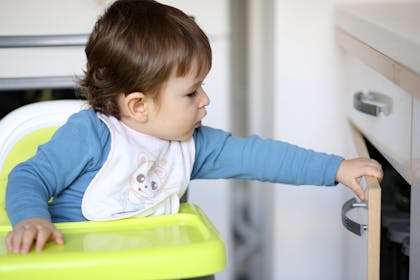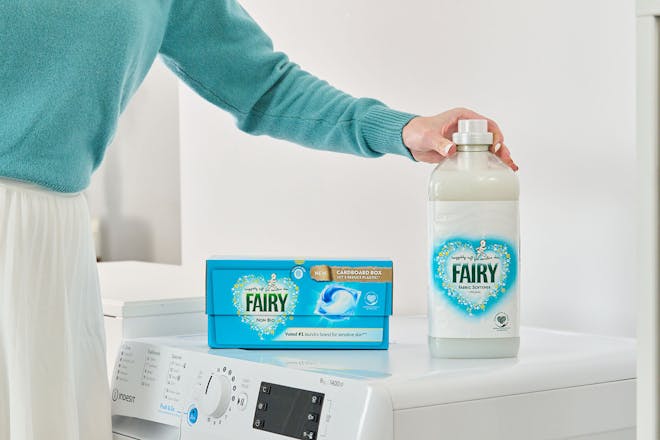6 essential tips for keeping your kids safe at home
Advertisement Promotion with Fairy Non Bio

Your child loves to explore. But with a surprising amount of everyday hazards in your home – from the contents of your kitchen cupboards to the batteries in your TV remote control – staying on top of child safety at home is essential.
Be alert is especially important because accidents can happen when you least expect them. According to the UK Health Security Agency (UKHSA), there are 450,000 visits to A&E for under-5s every year in England because of accidents at home.
Sadly, 60 children a year under the age of 5 die from injuries in and around the home. That’s 1 in 12 of all deaths of children aged between 1 and 4.
Luckily there are some simple things you can do to reduce the risk of an accident. Here we share 6 essential child safety rules you need to know.
1. Take a child’s eye view of your home
There are lots of hazards around the home that you probably won’t spot as an adult. So the first step for child safety is getting down to their level (literally) and looking around. You’ll probably spot lots of ‘hidden’ dangers that you simply hadn’t seen before: a hot cup of tea on the side, the sharp edge of a coffee table, a box of laundry pods just in reach of little hands …
Viewing your home through your child’s eyes will mean you can see the potential hazards and take steps to remove them.
And you've got an extra helping hand too ...
Fairy Non Bio, whose best-selling Fairy Non Bio PODS® are a favourite among parents, has now teamed up with the Royal Society for the Prevention of Accidents (RoSPA) to help parents keep their kids safe. And their advice for laundry pods is simple: keep them up, keep them closed, keep them safe.

2. Tie up blind cords
Looped cords can be lethal if they get caught round a child’s neck. According to RoSPA, up to 2 children a year die from accidents with blind cords in the UK - usually in a bedroom. And their research shows children between 16 months and 3 years are most at risk.
Blinds sold since 2014 should have safety devices to stop children being injured or killed. But millions of homes in the UK have older blinds without this safety feature. To keep your child safe, RoSPA has these tips:
- Only use blinds without a looped cord
- Cords on blinds and curtains should be kept short and out of reach of children
- Cords should be fastened in a figure of 8 after every use of the blind, making sure all the spare cord is secured on the cleat
- Don’t put your child's cot, bed, playpen or highchair near a window
- Never hang toys or objects that could be a strangulation hazard on a cot or bed
- Keep drawstring bags out of reach: a small child could get their head through the loop of the drawstring.
3. Be safe around water
Children can drown in as little as 5cm of water. Which means things you might not view as a hazard, like buckets of water in the garden or shallow baths, can actually be dangerous.
Never leave your child on their own at bath time. And when you’re running a bath, always stay in the bathroom – your child could try and climb in without you there. As soon as the bath is finished, pull out the plug.
It’s not just the risk of drowning: wet children are slippery, so be careful when you lift them out of the bath. And using a bath mat will stop them slipping inside the bath.
4. Watch out for falls
Ask any parent and they’ll agree: as soon as your baby is on the move, you need eyes in the back of your head. You see them playing happily on their mat, and seconds later they are clambering on furniture or attempting to crawl up the stairs.
Installing a stair gate at the top and bottom of your stairs will ensure they are off-limits to your child. And never leave your baby on their own on the changing table or sofa. (You can guarantee that’s the moment they’ll learn to roll over for the first time.)
Other simple safety measures include always using the harness when your baby is in their highchair or pram and keeping baby bouncers on the floor rather than on raised surfaces.

5. Keep household products out of reach
One of the key ways babies learn about the world around them is by putting things in their mouths. Yet this natural curiosity means an ‘alarming’ number of children end up in hospital after swallowing something poisonous, says RoSPA.
A spokesperson for the UK safety charity says, ‘If used correctly, these products are completely safe and very effective. But a recent survey found that nearly half of parents (45%) store liquid laundry capsules within reach of children, unaware of the risks involved.
‘That’s why Fairy Non Bio have joined forces with RoSPA to reduce the number of incidents involving liquid laundry capsules at home.’
When it comes to storing cleaning products, the team at Fairy Non Bio has a 3-step safety rule all parents need to know … keep them up, keep them closed, keep them safe.
Fairy Non Bio's new ECOCLIC box is recyclable and still has the reassuring 'click' to let you know it's been shut properly.
Keep all your cleaning and laundry products in high up cupboards that your child can’t reach. If this isn’t possible, put safety latches on your cupboard doors so your little one can't get into them.
6. Be aware of button batteries
Button batteries are in lots of household items, including remote controls, gaming headsets and even some toys like flashing wands or fidget spinners.
And they can have fatal consequences if a child swallows them. That’s because the battery reacts with bodily fluids like saliva and then releases a strong alkali that can burn through a child’s windpipe or stomach.
According to UK regulations, the batteries should be in a secure, child-proof compartment. But the Child Accident Prevention Trust warns that some toys bought online or from discount stores might not follow the safety rules.
Make sure you know which objects at home contain button batteries, and then keep them away from little hands. Also check that all the toys your child plays with meet safety requirements (they'll have a CE mark on them).
If you think your child has swallowed a button battery, take them straight to A&E. Don’t try and make your child sick, this could cause more harm.
Head to our Laundry Room hub for more family laundry tips.
Related stories
I'm a Dermatologist: here are 5 thins parents always ask about their child's skin



